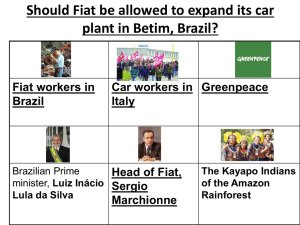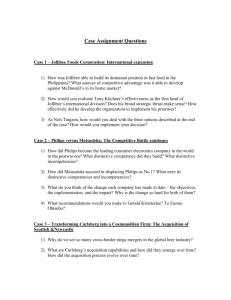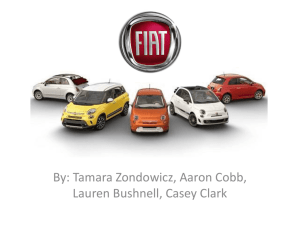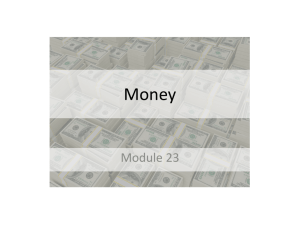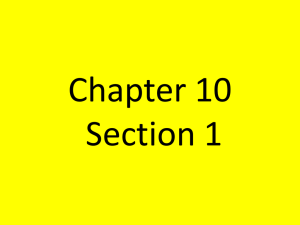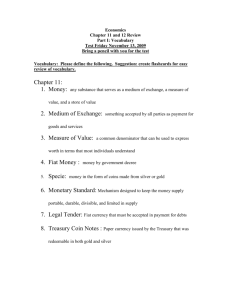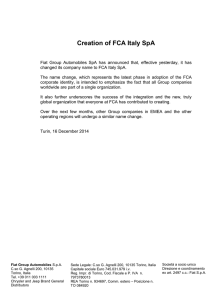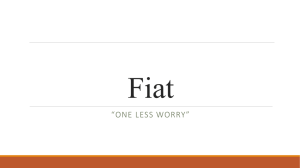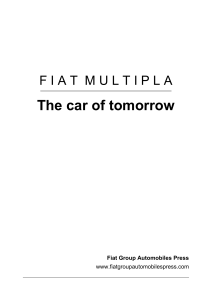hwk - Holy Family University
advertisement
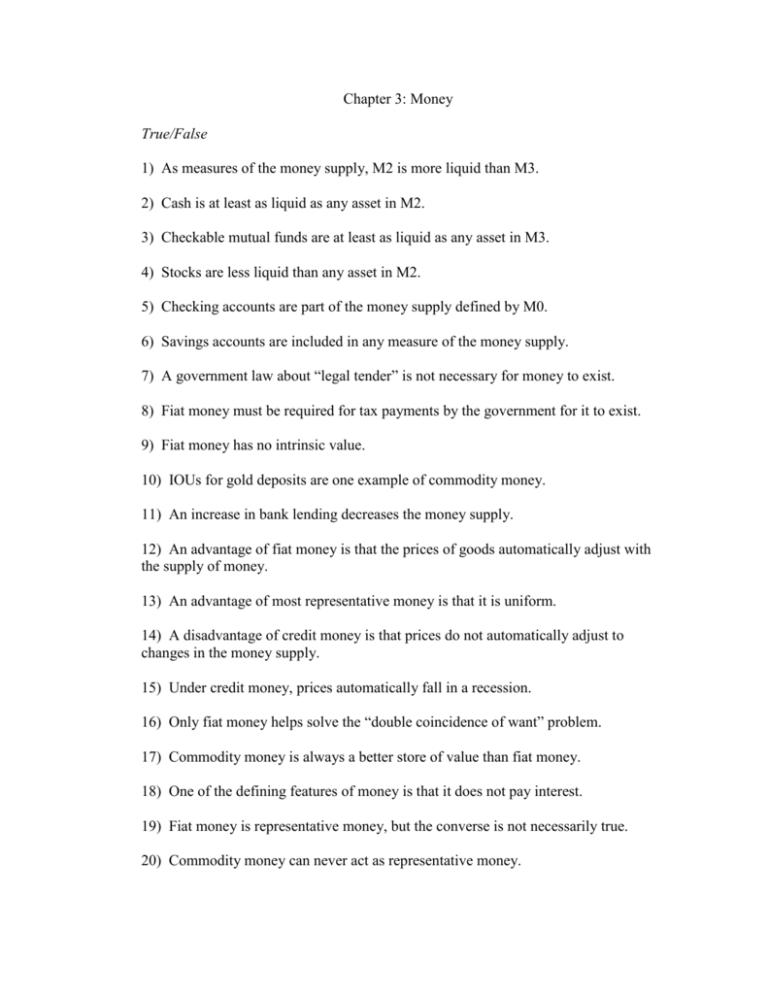
Chapter 3: Money True/False 1) As measures of the money supply, M2 is more liquid than M3. 2) Cash is at least as liquid as any asset in M2. 3) Checkable mutual funds are at least as liquid as any asset in M3. 4) Stocks are less liquid than any asset in M2. 5) Checking accounts are part of the money supply defined by M0. 6) Savings accounts are included in any measure of the money supply. 7) A government law about “legal tender” is not necessary for money to exist. 8) Fiat money must be required for tax payments by the government for it to exist. 9) Fiat money has no intrinsic value. 10) IOUs for gold deposits are one example of commodity money. 11) An increase in bank lending decreases the money supply. 12) An advantage of fiat money is that the prices of goods automatically adjust with the supply of money. 13) An advantage of most representative money is that it is uniform. 14) A disadvantage of credit money is that prices do not automatically adjust to changes in the money supply. 15) Under credit money, prices automatically fall in a recession. 16) Only fiat money helps solve the “double coincidence of want” problem. 17) Commodity money is always a better store of value than fiat money. 18) One of the defining features of money is that it does not pay interest. 19) Fiat money is representative money, but the converse is not necessarily true. 20) Commodity money can never act as representative money. 21) An advantage of commodity money is that deflation is impossible. 22) An advantage of commodity money is that prices cannot rise indefinitely. 23) A difficulty with gold is that it does not function well as a unit of account. 24) Rarity is an essential feature of money. 25) Credit money has inelastic supply. 26) Fiat money is less elastic than credit money. 27) Fiat money is self-equilibrating. Multiple Choice 1) In the absence of money, people a) must barter to trade. b) produce a greater variety of goods themselves. c) face the problem of “double coincidence of wants.” d) all of the above. 2) In the absence of money, people a) must barter to trade. b) produce a smaller variety of goods themselves. c) are unable to borrow or lend. d) all of the above. 3) When money is used to compare the relative value of goods, it is functioning as a a) medium of exchange. b) unit of account. c) store of value. d) all of the above. 4) In a barter economy with 4 goods, there are _____ prices. a) 2 b) 4 c) 6 d) none of the above 5) Money is a) anything that acts as a store of value. b) a divisible good that can be traded with many people. c) anything generally accepted for trade. d) all of the above. 6) Money a) is anything generally accepted for trade. b) does not have to be valuable except as a means of trade. c) can allow people to save more easily. d) all of the above. 7) Money a) does not have to be valuable except as a means of trade. b) must act as a long term store of value. c) must have value besides as a means to trade. d) all of the above. 8) Tulips don’t make very good money because they are particularly bad as a a) medium of exchange. b) unit of account. c) store of value. d) none of the above. 9) During a hyperinflation, money is not functioning well as a a) medium of exchange. b) unit of account. c) store of value. d) all of the above. 10) Money solves the “double coincidence of wants” problem since it acts as a a) medium of exchange. b) unit of account. c) store of value. d) all of the above. 11) Money is the only asset that acts as a a) medium of exchange. b) unit of account. c) store of value. d) all of the above. 12) Slips representing gold deposits with a bank are NOT an example of _____ money. a) fiat b) representative c) credit d) none of the above 13) Receipts for store tobacco are NOT an example of _____ money. a) commodity b) representative c) credit d) none of the above 14) Cigarettes are an example of _____ money. a) commodity b) fiat c) representative d) none of the above 15) Arrowheads are an example of _____ money. a) fiat b) representative c) credit d) none of the above 16) Rocks would not make very good money because they are not easily a) divisible. b) uniform. c) portable d) all of the above. 17) Diamonds do not make very good money because they are not easily a) divisible. b) durable. c) portable. d) all of the above. 18) Sand would not be able to function as money since it is not a) divisible. b) uniform. c) scarce. d) all of the above. 19) If a commodity money becomes easier to find or produce, prices denominated in that money will (ceteris paribus) a) rise. b) fall. c) stay the same. d) cannot be determined. 20) If an economy uses furs as money and the supply is suddenly cut in half, then prices of other goods in terms of furs will a) double. b) be halved. c) stay the same. d) none of the above. 21) If a fiat money becomes easier to produce, prices denominated in that money will (ceteris paribus) a) rise. b) fall. c) stay the same. d) cannot be determined. 22) Default risk is a potential problem for which of the following form(s) of money? a) commodity b) representative c) credit d) all of the above 23) Which of the following is part of any measure of the money supply? a) cash b) mutual funds c) bank reserves d) commercial loans 24) Which of the following is/are desirable attributes of a medium of exchange? a) durability b) elasticity of supply c) divisibility d) all of the above 25) Which of the following is/are desirable attributes of a medium of exchange? a) edibility b) elasticity of demand c) divisibility d) all of the above 26) Which of the following is/are desirable attributes of a medium of exchange? a) the ability to carry it b) there is a relatively fixed amount available c) it is difficulty to break up d) all of the above 27) The biggest problem with credit money is a) b) c) d) its weight-to-value ratio. elasticity of supply. default risk. none of the above. 28) The biggest problem with credit money is a) divisibility. b) elasticity of supply. c) portability. d) none of the above. 29) An advantage of credit money is a) elasticity of supply. b) default risk. c) indivisibility. d) none of the above. 30) A disadvantage of credit money is a) elasticity of supply. b) weight to value ratio c) indivisibility. d) none of the above. 31) The dollar is an NOT an example of a) fiat money. b) representative money. c) credit money. d) The dollar is an example of all of the above. 32) Which type of money is the most difficult to counterfeit? a) fiat b) commodity c) representative d) credit 33) Which of the following types of money are not self-equilibrating? a) commodity b) representative c) fiat d) all are self-equilibrating Short Answer 4) Why do economists say that money helps to increase specialized production? Trade is more difficult in a barter economy, so people produce more of their own goods since they are not sure they can get them in trade. Money allows them to specialize since they are confident they can trade for other goods they want. 5) What is the difference between commodity and fiat money? 6) Why would silver dollar coins be a better store of value than gold bars? The coins would have a minimum value of a dollar, while the gold bars have no such guarantee. 11) In what way would apples be better than diamonds as a medium of exchange? 19) Could prices for goods rise indefinitely under commodity or fiat money? Explain. 21) What are the advantages and disadvantages of commodity money? The major advantage is that it is self-equilibrating. Some of the disadvantages are that it has an inelastic supply, it is more difficult to store, more difficult to transport, it is indivisible, and authentication costs are relatively high.

